Building a Neighborhood-Specific Gazetteer for a Digital Archive
Christine S. Lam and John P. Wilson
Department of Geography
University of Southern California
Los Angeles, CA 90089-0255
and
Deborah A. Holmes-Wong
Information Service Division
University of Southern California
Los Angeles, CA 90089-0251
Abstract. This paper presents the strategy used to build a gazetteer for the Los Angeles Digital Archive. The archive contains more than 250,000 objects in numerous formats, and a gazetteer is needed to (1) facilitate the specification of geographic footprints in the Dublin Core metadata records and (2) support the search for and retrieval of selected objects based on location, time, format and/ or keyword. The search and retrieval interface utilizes ArcIMS 4.0, and the neighborhood shapes specified in the gazetteer were generated from published map labels in ArcInfo 7.2.1. The gazetteer and advanced search capabilities are integral components of USC’s Next Generation Library Initiative.
1. Introduction
A group of scholars and librarians at the University of Southern California have been working on a digital archive to represent, find, evaluate, and retrieve primary research materials (i.e. objects) about the Los Angeles Region for the past six years. When completed, the Los Angeles Digital Archive will constitute a substantial digital archive of primary research materials about what today is the Los Angeles Metropolitan Area. The system aims to integrate radically different information types rapidly through place, time, format, and keyword indexing. The individual objects that currently comprise the archive have been catalogued using Qualified Dublin Core for the metadata records (see http://dublincore.org/documents/2000/07/11/dcmes-qualifiers
for additional information about Dublin Core Qualifiers). The system is
implemented in Oracle 9i to take advantage of its XML capabilities.
The power of the Los Angeles Digital Archive (LADA) can be traced to the metadata that are used to support searches based on place, time, format, and keyword. Place here refers to the geographic footprint (e.g. the area covered by an aerial photograph). Time refers to the temporal footprint (e.g. the date on which a building was photographed). The format refers to the method used to represent individual items. The eight DCM1 types – collection, dataset, event, image, interactive resource, service, software, sound and text – and an additional type for geospatial materials are currently supported (see http://dublincore.org/documents/2000/07/11/dcmi-type-vocabulary
for additional information about the DCM1 Type Vocabulary). All items are part of larger collections (e.g. strip maps are part of the Automobile Club of Southern California collection) and can be retrieved by collection name as well.
The vision for LADA was first laid out and implemented as a part of the "ISLA-Information System Los Angeles" prototype that was developed by Philip Ethington, Li Hunt, and colleagues at USC (see Hunt and Ethington (1997) for details). ISLA was conceived as a web-based, distributed system that would allow separate institutions to contribute to a regional meta-collection without surrendering their digital assets. This concept would allow individual institutions to ingest content on their own servers and to set access parameters for the global user community. Library patrons would have perceived a single collection that in reality would have been composed of several separately held databases integrated through ISLA and they would have been able to access (i.e. download) a given object only to the extent that the owner of that collection was willing to make such objects available given this design
The system now under construction implements this vision and will provide scholars and students immediate access to a large number and variety of primary materials focused on Southern California. The new system has an ArcIMS-based client interface and a backend supported by ArcSDE, Oracle 9i, and XML. The browser
will offer the library patron a web-based query form with an interactive map that can be used to delineate the places or locations of interest and a series of pull down menus that can be used to specify the time periods, formats, collections, and keywords of interest (Figure 1). The system will also incorporate a gazetteer or list of geographic names that can be used in place of and/ or with the interactive map display to specify places of interest. Several frames will also be provided for the display of the search results. The first of these frames will provide a brief description of the selected items and a thumbnail image of the object if it was saved as an image file or geospatial dataset. From there, the user will be able to click on the metadata summary to obtain the Dublin Core metadata description for the selected objects or they can pick the selected objects and download copies of them to their personal computers or workspaces. For objects like census information that are stored as geospatial datasets, the library patron will be able to construct and download one or more thematic maps that they construct on the fly as well as the geospatial data sets themselves.
This paper focuses on the development of the gazetteer service and a gazetteer database for the Los Angeles Region. The service and accompanying database will provide a bridge between the vernacular place names and other terms that we use to talk about this region and other parts of the world and the formal spatial referencing systems that are used by computers (Goodchild 1999). This linkage
serves two purposes: (1) it will allow archivists and other data providers to specify geographic names instead of geospatial coordinates for the geographic footprints that are saved as a part of the Dublin Core metadata records; and (2) it will allow library patrons to start with a geographic name and find objects that are described with either geographic names or geospatial coordinates. The first will reduce the time, effort, and
cost incurred in specifying the geographic footprints in the metadata records, whereas the second will allow the library patron to send a query to the gazetteer database to obtain the geographic location which can then be used as a spatial query to find the relevant objects and/ or metadata records.

Figure 1: The University of Southern California Geospatial Browser.
The remainder of the paper is divided into four sections. The next section describes some of the challenges and problems encountered in building these gazetteer components, and the results of some recent work that may offer a way forward.
The third section describes the methods and data sources used to add
neighborhood names and shapes to our Los Angeles gazetteer and the fourth
section describes some of the strengths and shortcomings of the resulting
gazetteer items that were produced. The final section offers some conclusions and ideas for future work.
2. Previous Work
The Alexandria Digital Library at the University of California-Santa Barbara, launched in 1994, developed several components that have been important in the conceptualization and building of distributed and geographically referenced digital map and image libraries (see http://www.alexandria.ucsb.edu for additional details).
The initial version of the ADL gazetteer was
constructed by extracting the name, location, and type of selected entries from two online gazetteers maintained by the U.S. federal government covering the United States and its territories (the U.S. Geological Survey’s Geographic
Names Information System; see http://www-nmd.usgs.gov/www/gnis for further
details) and the remainder of the world (the National Imagery and Mapping
Agency’s GeoNames Server; see http://www.nima.mil/gns/html for further details) (Hill and Zheng 1999). These sources contain over 6 million names but their use demonstrates a high level, top-down approach and means that the library patron was not likely to find gazetteer entries for small regions and counties due to the scope of the sources. However, the initial experience of building this gazetteer led to further work to develop a Gazetteer Content Standard and Feature Type Thesaurus, and these innovations can support the development and deployment of gazetteer services at multiple sites.
The Gazetteer Content Standard specifies a
common set of terminology and definitions for the documentation of data to guide the development of metadata for each of the geographic names (Hill and Zheng 1999). This standard provides lists of names and variant names for places and information about these names, the spatial footprints, the source or authority of the name, the language etymology, pronunciation, dates when the name was/ is used, etc. Each name is assigned to one or more Feature Type Thesaurus category and features can be related to one another with links such as "IsPartOf" and "IsCapitalOf" (Hill 1999). Figure 2 shows the major features of this standard. The asterisks (*) and bolded names indicate required (mandatory) data elements and (R) indicates repeatable data elements in Figure 2. There are varying numbers of sub elements for all of the major sections (similar to that
shown for Geographic Name in Figure 2) and most of the major sections also
include attribution elements for contributors and source to facilitate
contributions to one geographic feature description from multiple contributors.
The ADL team has also developed a new
thesaurus of place/feature categories to facilitate the consistent description of types of places and features in the ADL Gazetteer (Hill and Zheng 1999). The candidate terms were selected from the U.S. Geological Survey’s Geographic Names Information System and the National Imagery and Mapping Agency’s GeoNames Server and used to build a hierarchical thesaurus. Six top-level terms (major categories) and 87 second-level terms were chosen to give structure to the hierarchy (see Figure 3 for additional details) and the depth of the hierarchy which sometimes extends to three or four levels but occasionally stops after one or two levels was heuristically determined based on the specification likely to be needed by
ADL. The Feature Type Thesaurus, which includes broad term/narrow term
relationships, synonymous terms, and related terms, is an evolving document that can be modified by adding additional term variants and making changes to the structure and preferred terms as necessary (Hill and Zheng 1999). The current version of this thesaurus has close to a 5:1 ratio of lead-in vocabulary to preferred terms (209 preferred terms and 978 lead-in terms) and it bridges the various typing terminologies incorporated in six online gazetteers (see Hill (2000) for additional details).

Figure 2:The ADL Gazetteer Content Standard (modified from Hill et al. (1999) and Hill (2000)).
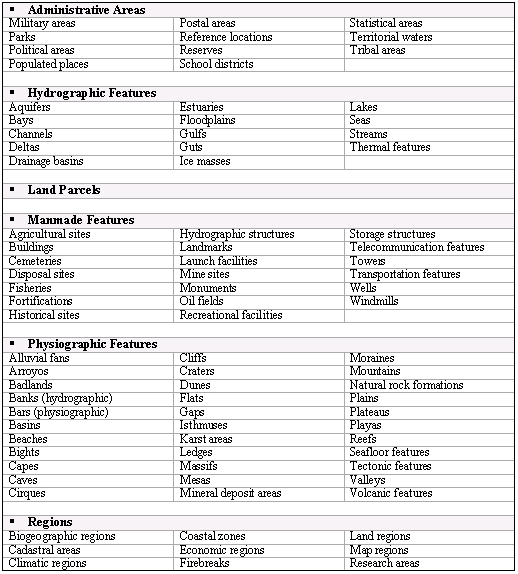
Figure 3: The ADL Feature Type Thesaurus Showing Top- and Second-Level Terms (modified from Hill and Zheng (1999) and ADL Project Website).
The need to specify
spatial footprints for the geographic names is perhaps the most expensive and difficult task in building gazetteers for specific regions or places. The pre-ADL gazetteers and gazetteer-like services often represented the spatial footprints as points, whereas digital libraries require spatial footprints that specify the spatial extent as polygons and/or bounding rectangles and not just as point locations to facilitate search and retrieval of generated content (Harpring 1997a,b; U.S. Geological Survey 1998). Two characteristics contribute to the difficulty of this task. The first is the fact that many natural and man-made features have fuzzy or indeterminate boundaries – see Burrough and Frank (1996) for an extended discussion of this phenomenon. This problem is often compounded by a second one – the tendency for the geographic footprint representing the location of a named place or feature to take on multiple representations depending on the type of representation method used (points, bounding box, line, polygon, grid cell, etc.), source, resolution (scale, level of generalization, etc.), and time period (given that the extents of some
features will change over time).
Hill (2000) also noted these problems and pointed to the multitude of sources and technologies (i.e. existing gazetteers, GIS datasets, research publications, GPS measurements, etc.) that might be used to find and/ or generate spatial footprints. The challenge is two-fold: there is a need to select one or more appropriate footprints for each specific place and there needs to be a way to record multiple representations with specific entries in the Gazetteer Content Standard (realizing that the character and extents of many places in southern California have changed tremendously during the past 200 years). Fortunately, the second need was anticipated and an effective solution is incorporated in the design of the ADL Gazetteer Content Standard (see Figures 2 and 4 for details).
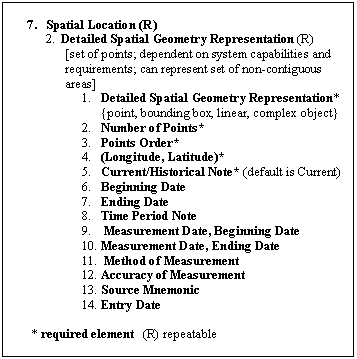
Figure 4: Specification of location in ADL Gazetteer Content Standard (from Hill (2000)).
Turning to the first
need, Hill (2000) advocated using a "satisficing" criterion to select spatial footprints for digital gazetteers. Modeled after the law of diminishing returns as expressed by Simon (1979), this approach means that we do not seek out optimal solutions (i.e. the most precise and detailed footprints) because the costs are too high and we instead focus on solutions that are satisfactory given the cost. Hill (2000) used two examples – the choice of bounding boxes over detailed polygons and the level of detail (i.e. number of vertices) used to describe the polygon boundary in the latter case – to illustrate this approach. However, the ramifications extend further than both of these examples and include the choice of representation method (point, bounding box, linear, complex object, etc.) and the sources and/ or methods used to generate the
spatial footprints.
Alani et al. (2001), for example,
recently proposed the Dynamic Spatial Approximation Method (DSAM) for estimating spatial footprints from the locations of point sites that lie inside or outside some region of interest. The DSAM is based on Voronoi diagrams in which the polygons represent the space closest to the associated point relative to all other points. This method can be used to infer spatial relations between regions in the absence of digitized boundaries: the resulting approximations provide measures of areal extent and can be used to evaluate spatial relationships such as distance, direction, and spatial adjacency. The Thiessen polygons that are
identified with DSAM might also be used to facilitate the search for and
retrieval of geocoded objects in a digital library, although we found that the results from using this approach were very sensitive to geographic variations in the character and density of the build environment from our work in Los Angeles County.<
3. Methods and Data Sources
Many authors have described the historical evolution of Los Angeles’ social landscape and highlighted its demographic transition from a small frontier town to a metropolis and world city (e.g. Hise 1997, Fulton 2001). The metropolitan area now spills over the borders of Los Angeles County into neighboring Ventura, San Bernardino, Riverside, and Orange Counties and the built-up areas in many of the individual cities have coalesced to form one large contiguous urban area. Several books and articles describe the emergent spatial patterns that have produced a series of very distinctive neighborhoods and identified the historical processes that led to their production (e.g. Allen and Turner 1997, Modarres 1998). These neighborhoods are important in people’s everyday lives and for navigating our way around this large metropolitan area, and there are processes now underway to use them to mobilize community participation in planning and decision-making (e.g. Talen 1999).
Given these developments, we chose
cities and neighborhoods as the basic feature types for building a Los Angeles County gazetteer. Cities are straightforward because their inception dates are well known and their boundaries are captured in numerous GIS datasets. The fuzzy and impressive nature of neighborhoods, in contrast, causes many difficulties and pointed to the need to find a creative "satisficing" solution for this feature type. The new method described below incorporated three tasks – building a point theme in ArcView 3.2, measuring the proximity between adjacent pairs of points, and generating circular shaped footprints (i.e. polygons) in ArcInfo 7.2.1 for specific neighborhoods. The data sources and GIS operations invoked for these tasks are described in the subsections that follow.
3.1. Building the Point Theme
A point theme was constructed in ArcView 3.2 using the neighborhoods listed in the 2001 Los Angeles County Street Guide
and Directory (Thomas Bros 2001). These popular books, which are updated
annually, show city boundaries, freeways, streets, and other major landmarks. The labels identifying the 88 cities and 218 neighborhoods recorded in the 2001 Los Angeles County Street Guide and Directory are printed in blue and a larger font size is used to distinguish city from neighborhood labels. In addition, some neighborhoods appear more than once because their names are printed on more than one page.
Street and highway layers acquired from Geographic Data Technology, Inc. were added to a new view and used along with the "heads-up" digitizing tools in ArcView 3.2 to add point features to the neighborhood point theme. The neighborhood labels in the Thomas Guide were treated as neighborhood centroids and used to guide the locations of the point features. Mean x, y coordinates were calculated by hand and used for neighborhoods with two or more labels in the 2001 Los Angeles County Street Guide and Directory.
3.2 Proximity Measurements
The distances between each of the digitized points and the closest neighboring points were measured next with the distance measurement tool in ArcView 3.2. The distances between these points varied substantially (Figure 5), although they were generally shorter in densely populated areas and larger in the northern half of the county. Los Angeles County was therefore divided into four regions – Lancaster/Palmdale, the San Fernando Valley, San Gabriel Valley, and the Los Angeles Basin – and mean distances between adjacent pairs of neighborhoods were calculated and used to build circular polygons in each of these regions(Figure 5).
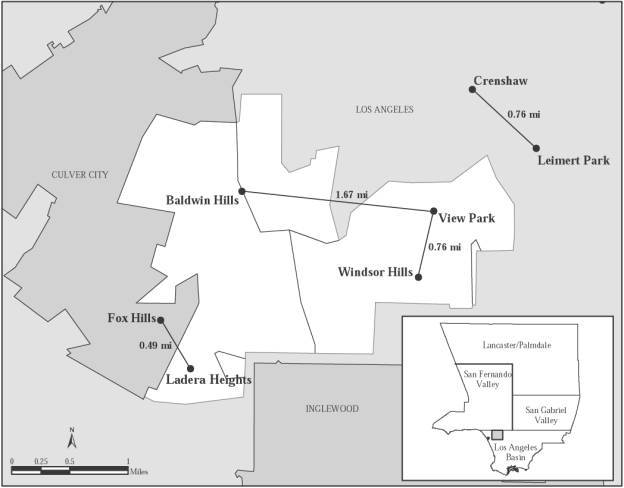
Figure 5: Map showing distance measurements for adjacent neighborhoods in part of Los Angeles County.
3.3. Generating Circles and Polygons
The point theme developed in ArcView 3.2 was transferred to ArcInfo 7.2.1 and transformed into an ASCII file with x, y coordinates using the Ungenerate command. These x, y coordinates and the four mean distances between adjacent neighborhood centroids calculated with the previous step were then used with the Generate command in ArcInfo 7.2.1 to build a series of circular-shaped polygons. Figure 6 shows the neighborhood footprints that were generated with this new method for the map extent displayed in Figure 5. This new map shows how similar radii were used with each of the neighborhood points (i.e. labels) to generate circular-shaped polygons in this portion of Los Angeles County.
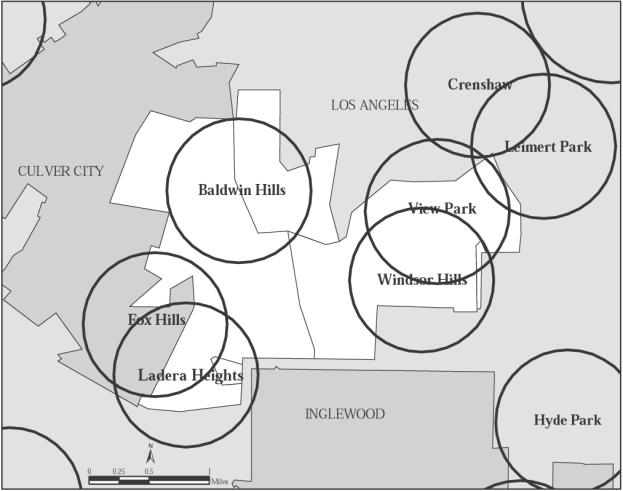
Figure 6: Map showing neighborhood footprints generated with new method for map extent displayed in Figure 5.
4. Results
Figure 7 shows the 218 neighborhood shapes (i.e. footprints) that were delineated with this new method superimposed on a series of polygons that record the boundaries of the 88 cities that have been incorporated to date in Los Angeles County. Table 1, in turn, lists the four regions and summarizes the number of neighborhood pairs for which distances were measured, the mean distances between adjacent neighborhood centroids, and the radii used to construct the circular-shaped polygons shown in Figure 7. It is particularly important to note that the circles vary in size depending on the region in which they fall and taken as a whole, they share two desirable characteristics: (1) they do not cover the entire county (i.e. they are not space filling), and (2) there are numerous neighborhood footprints that overlap one or more other neighborhood footprints.
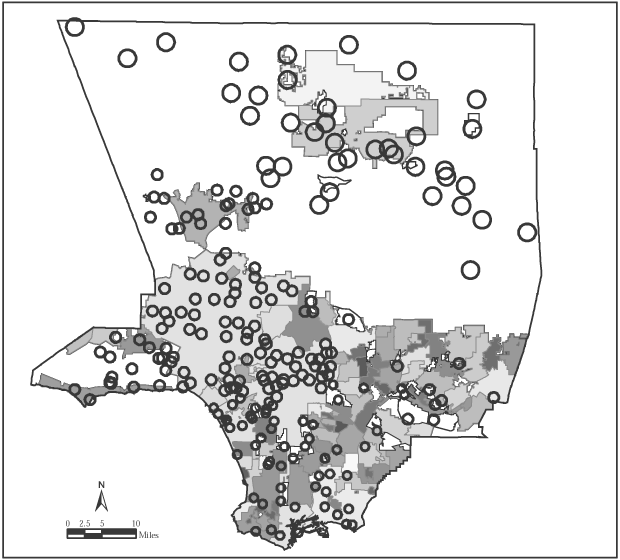
Figure 7: The neighborhood footprints used for the Los Angeles County Gazetteer.

Table 1: Final distance measurements used to generate neighborhood footprints.
The first characteristic noted above (i.e. that the neighborhood shapes do not cover the entire county) is desirable because there are many unpopulated areas in the northern half of the county and in the Santa Monica and San Gabriel Mountains. Hence, there is no reason to extend the neighborhood boundaries to fill the entire land area in these parts of the county (as would happen with the Thiessen
polygons constructed with the method of Alani et al. (2001) for example). In addition, the reliance on the mean distances recorded in Table 1 to construct the circular-shaped polygons shown in Figure 7 meant that there was no need to delineate the built-up area(s) throughout the county – which would constitute another difficult, time-consuming, and expensive task that would need to be repeated at regular intervals to capture the changes in urban boundaries throughout the county.
The second characteristic noted above (i.e. the overlapping neighborhood footprints) is also desirable because the boundaries are inherently fuzzy and there are numerous societal actors and trends that will tend to keep them imprecise. Real estate agents and residents living next to more affluent neighborhoods and/ or areas that are perceived to be more desirable and/or affluent may want to extend the boundaries of these adjacent neighborhoods to include their properties for example. Figure 6, for example, shows six areas of the county that might be assigned to two or more neighborhoods at different times with the method described in this paper. Fox Hills spills over into Ladera Heights (and vice versa), Windsor Hills spills over into View Park (and vice versa), View Park spills over into Crenshaw and/ or Leimert Park and vice versa in this portion of Los Angeles County for example. The white areas in Figures 5 and 6 show unincorporated parts of the county that are completely surrounded by one or more cities. Overall, there are 86 instances where some part of the county is assigned to two or more neighborhoods in Figure 7.
5. Conclusions
The new method presented in this paper used the distances between pairs of nearest neighborhoods to generate circular-shaped neighborhood footprints for inclusion in a Los Angeles Gazetteer. The results show that this method produces neighborhood shapes with several desirable characteristics given the imprecision inherent in neighborhood characteristics and boundaries. In addition, this new method is cheap, reproducible, and extendable. The circular-shaped footprints recorded in Figure 7 were generated using simple GIS tools and a published street map guide as input. The method is reproducible given that others could utilize this same method with the same data sources and generate the same results. The method is extendable in the sense that others could use it with
equivalent data to generate neighborhood shapes in other metropolitan areas
(e.g. Houston, Texas).
Some further refinements of this method may be needed to specify how these shapes have changed over time. Thomas Guides for Los Angeles County have been published for over 75 years and they may be able to be used with the current method to develop neighborhood footprints for earlier years as well. However, some additional knowledge of the extent of the built-up area may be needed to help delimit the neighborhood shapes in these earlier years and this would increase both the cost and complexity of using these types of methods to build local gazetteers like the Los Angeles County Gazetteer envisaged here.
6. References
Alani H, Jones C B, and Tudhope D (2001) Voronoi-based region approximation for geographical information retrieval with gazetteers. International Journal of Geographical Information Science 15: 287-306
Allen J P and Turner E (1997) The Ethnic Quilt: Population Diversity in Southern California. Northridge, CA: The Center for Geographical Studies, California State University
Burrough P A and Frank A U (1996) Geographic Objects with Indeterminate Boundaries. London, Taylor and Francis
Fulton W (2001) The Reluctant Metropolis. Baltimore, MD: The John Hopkins University Press
Goodchild M F (1999) The future of the gazetteer. WWW document, http://www.alexandria.ucsb.edu/~lhill/DGIE_website/perspectives/brandt.htm
Harpring P (1997a) The limits of the world: Theoretical and practical issues in the construction of the Getty Thesaurus of Geographic Names. In Proceedings of the Fourth International Conference on Hypermedia and Interactivity in Museums (ICHIM ’97), Archives and Museum Informatics, Le Louvre, Paris: 237-251
Harpring P (1997b) Proper words in proper places: The thesaurus of geographic names. MDA Information 2: 5-12
Hill L L (1999) Gazetteer and collection-level metadata developments. In Kaser R T and Kaser V C (ed.) Metadiversity: The Grand Challenge for Biodiversity Information Management through Metadata. Reston, VA: U.S. Geological Survey, Biological Resources Division: 141-145
Hill L L and Zheng Q (1999) Indirect geospatial referencing through place names in the digital library: Alexandria Digital Library experience with developing and implementing gazetteers. In Proceedings of the Sixty-second Annual Meeting of the American Society for Information Science, 31 October-4 November 1999, Washington, D.C.: 57-69
Hill L L, Frew J, and Zheng Q (1999) Geographic names: The implementation of a gazetteer in a georeferenced digital library. WWW document, http://www.dlib.org/dlib/january99/hill/01hill.html
Hill L L (2000) Core elements of digital gazetteers: Placenames, categories, and footprints. In Borbinha J and Baker T (ed.) Research
and Advanced Technology for Digital Libraries. Berlin, Springer: 280-290
Hise G (1997) Magnetic Los Angeles: Planning the Twentieth Century Metropolis. Baltimore, MD: The John Hopkins University Press
Hunt L and Ethington P E (1997) The utility of spatial and temporal organization in digital library construction. Journal of Academic Librarianship 23: 475-483
Modarres A (1998) Putting Los Angeles in its place. Cities
15: 135-147
Simon H (1979) Rational decision making in business organizations. American Economic Review 69: 493-513
Talen E (1999) Sense of community and neighborhood form: An assessment of the social doctrine of New Urbanism. Urban Studies 36: 361-1379
Thomas Bros (2001) The Los Angeles County Street Guide and Directory. Irvine, CA: Thomas Bros Maps
United States Geological Survey (1998) Geographic Names Information Systems (GNIS). WWW document, http://mapping.usgs.gov/www/gnis
Christine S. Lam
Graduate Research Assistant
Department of Geography
University of Southern California
John P. Wilson
Professor, Department of Geography
Director, USC GIS Research Laboratory
University of Southern California
and
Deborah A. Holmes-Wong
Project Manager
Information Service Division
University of Southern California